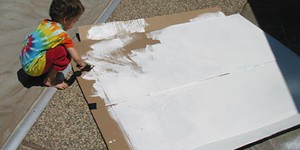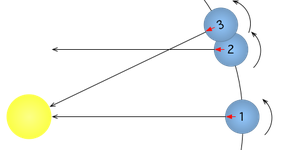Others Like “Correlation of Coronal Mass Ejections with the Solar Sunspot Cycle” (top 20 results)
|
The sun sometimes releases huge bursts of electrified gases into space. These bursts are called coronal mass ejections (or CMEs). When CMEs are directed towards Earth they can generate auroras, the spectacular atmospheric displays also known as "northern lights" (photo by Chris VenHaus, 2001). In this project you'll use images from the SOHO satellite to measure how fast CMEs move.
Read more
Sunspot activity has been monitored continuously since about 1700. The historical data shows that sunspot activity rises and falls in a roughly 11-year cycle. This project shows you how you can use both graphical and statistical analysis to look for patterns in cyclical data.
Read more
Here's a cool project that shows you how to use images from an orbiting observatory to measure how fast the Sun rotates.
Read more
Make a pinhole projector (see Measuring the Diameter of the Sun and the Moon). Use the pinhole to project an image of the Sun onto a wall or a piece of paper. Do you notice any dark spots on the projected image? Trace the projected image and count the dark spots. Use your pinhole projector to make images of the Sun at the same time of day for several consecutive days. How does the pattern of spots change? Can you use your data to figure out how fast the Sun rotates? Sunspot activity rises…
Read more
The Sun is the ultimate source of the energy that powers weather systems on Earth. Geomagnetic storms are sun-powered storms in the upper atmosphere, arising from energized particles that are periodically ejected by the Sun. Among other effects, geomagnetic storms can wreak havoc with earth-orbiting satellites, and disrupt satellite communications. The global positioning system (GPS) is a network of 24 earth-orbiting satellites that constantly sends radio signals through the earth's…
Read more
Many things in nature are periodic: the seasons of the year, the phases of the moon, the vibration of a violin string, and the beating of the human heart. In each of these cases, the events occur in repeated cycles, or periods. In this project, you will investigate the periodic motion of a spring, using a mini Slinky®. You can also measure the motion of your spring using a smartphone equipped with a sensor app. Basic physics will then allow you to determine the Hooke's Law spring constant.…
Read more
What do humans need to survive? We need food, water, and warm shelter. We all need a warm place to live, particularly when it's chilly outside. How do many of us warm our houses or apartments? We depend on fossil fuels to supply gas and electricity to our heaters. But burning fossil fuels to create energy is harmful to the environment. What if there was a way to warm our homes without burning fossil fuels and it was free? In this science fair project, you will build a solar air heater and see…
Read more
Do you wake up at the crack of dawn, or do you need an alarm clock to wake you up each morning? It may surprise you that the two are not always in synch. Nowadays, we use Standard Time to set our watches instead of Solar Time. Which method of timekeeping is the most accurate? Get ready to synchronize your watches!
Timekeeping is the science of how to keep time with precision and accuracy. People have been finding ways of measuring time for thousands of years, usually based on the movements…
Read more
"How do you frighten a grasshopper? And what does that have to do with light?" These are a couple of questions you're probably asking yourself after reading the title. Well, The Frightened Grasshopper Solar-Powered Bug is actually a toy grasshopper that vibrates when it is placed in sunlight or near a lightbulb. It stores up the energy from light, and converts it into motion. You will use this fun toy to explore how the brightness of the light affects the motion of the solar-powered insect.
Read more
Isn't it nice to take a nice, hot shower or bath after a long day of playing outside? But have you really thought about how the hot water in your shower or bath gets hot? Sure, the water heater in your house gets it hot, but what makes the water heater work? Water heaters are powered by natural gas or electricity. But are there any other ways to heat water? What about using the Sun? In this science fair project, you'll give it a try by capturing energy from the Sun to heat water.
Read more
|
Explore Our Science Videos
Popsicle Stick Paddle Boat
Valentine's Day Candy Delivery Robot
How Strong Is Your Hair? – STEM Activity











